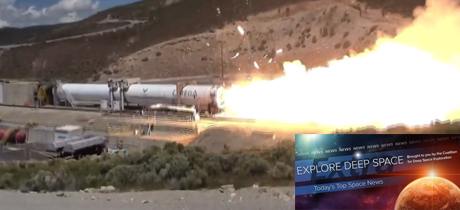In Today’s Deep Space Extra… NASA Administrator Jim Bridenstine expresses confidence that bipartisan support from Congress will support efforts to accelerate a human return to the Moon. He spoke as congressional auditors warned that NASA’s major programs are facing cost and schedule challenges. NASA’s James Webb Space Telescope (JWST) completes pre-launch thermal vacuum testing. Japan advances efforts to collect a second sample from the asteroid Ryugu.
Human Space Exploration
Bridenstine says debate only beginning over funding 2024 return to the Moon
SpaceNews.com (5/30): The price tag for accelerating a human return to the surface of the Moon from 2028 to 2024 is only beginning to emerge, NASA Administrator Jim Bridenstine told a meeting of NASA’s Advisory Council on Thursday. Bridenstine, looking to a legacy of bipartisan support from lawmakers for NASA initiatives, expressed confidence that Congress will provide the money to achieve the new goal.
GAO: NASA cost and schedule performance deteriorating
Spacepolicyonline.com (5/30): A range of major NASA programs are facing significant cost and schedule challenges, according to an audit from the U.S. General Accountability Office (GAO), an arm of Congress. The issues could affect new NASA initiatives intended to accelerate a human return to the surface of the Moon from 2028 to 2024, according to auditors.
Space Science
NASA’s James Webb Space Telescope (JWST) emerges successfully from final thermal vacuum test
Coalition Member in the News – Northrop Grumman
NASA/Goddard Space Flight Center (5/30): NASA’s successor to the 29-year-old Hubble Space Telescope, the James Webb Space Telescope (JWST), is emerging from cost and schedule challenges as it strides towards a March 2021 liftoff. Recently, the JWST spacecraft element, completed its final pre-launch thermal vacuum test at Northrop Grumman facilities in California.
Japan bombed an asteroid and now it’s preparing to collect the debris
C/NET (5:29): This week, the Japan Aerospace Exploration Agency (JAXA) succeeded in placing a second target marker on the surface of the asteroid Ryugu. The first attempt in mid-May was aborted by the agency’s Hayabusa 2 spacecraft, which is on a mission to collect samples of Ryugu for return to Earth in late 2020. The first collection of surface material unfolded on February 22. A second collection effort, one that would gather a sample of subsurface material, is being planned the coming week with the help of the new target marker.
Why do some Hubble images have that chunk taken out of the corner?
Universe Today (5/30): How does the world’s premier space based observatory deal with its aging optics?
Other News
FAA extends comment period on commercial launch regulations
SpaceNews.com (5/30): The FAA has agreed to an industry sought extension for a comment period on pending changes to the regulation of U.S. commercial rocket launch activities. The deadline for public comment has been extended from June 14 to July 30.
Northrop Grumman looking into dramatic nozzle anomaly on Omega rocket motor
Coalition Member in the News – Northrop Grumman
CBS news via Spaceflightnow.com (5/30): Northrop Grumman’s Omega rocket, a development initiative for the launch of U.S. national security payloads, experienced a rocket nozzle problem during a test firing on Thursday in Utah as the test was coming to a conclusion.
Proton rocket lifts off with Yamal 601 communications satellite
Spaceflightnow.com (5/30): A Russian Proton rocket launched from the Baikonur Cosmodrome in Kazakhstan on Thursday with a communications satellite serving a range of civil and government customers.
Lego launches a 1,087-piece Apollo 11 lunar lander model, astronauts included
GeekWire.com (5/30): Lego is on board for marking the 50th anniversary of the Apollo 11 Moon landing on July 20. The toy company in introducing a more than 1,000 piece building set that recreates the historic event.

